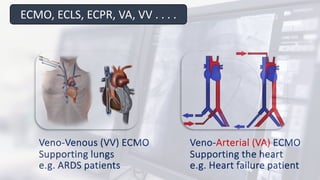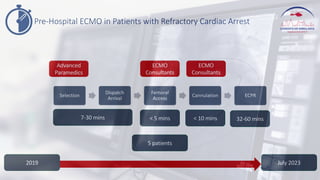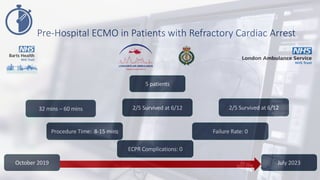ECPR at the Roadside - Mamoun Abu-Habsa - TBS24
- 1. ECPR at the Roadside? Dr Mamoun Abu-Habsa MRCS(Ed) Dip IMC PGCE FRCEM FFICM Consultant in Critical Care & Trauma Regional Clinical Director for Adult Critical Care Retrieval Barts Health NHS Trust, UK The Big Sick Conference, Zermatt 2024
- 4. Veno-Venous (VV) ECMO Supporting lungs e.g. ARDS patients Veno-Arterial (VA) ECMO Supporting the heart e.g. Heart failure patient ECMO, ECLS, ECPR, VA, VV . . . .
- 12. - Well designed - Standard protocol - High quality CPR - Consistent practice - Single centre - Variation in protocol / practice - Limited or no experience in some centres - Larger study - Multi-centre
- 14. • 999 • Bystander CPR/AED Recognition BLS / ALS EMS • Packaging • Loading • Disembark ing Transport Handover ER / Cath Lab / OR Why at the roadside? 5 mins 10-30 mins 5-40 mins 30-75 mins
- 15. Pre-Hospital ECMO in Patients with Refractory Cardiac Arrest
- 17. Pre-Hospital ECMO in Patients with Refractory Cardiac Arrest Selection Dispatch Arrival Femoral Access Cannulation ECPR Advanced Paramedics 7-30 mins 2019 July 2023 5 patients < 5 mins < 10 mins 32-60 mins ECMO Consultants ECMO Consultants
- 18. Pre-Hospital ECMO in Patients with Refractory Cardiac Arrest October 2019 July 2023 5 patients 32 mins – 60 mins 2/5 Survived at 6/12 2/5 Survived at 6/12 Procedure Time: 8-15 mins Failure Rate: 0 ECPR Complications: 0
- 19. 1 2 3 4 5
- 20. Set criteria Set safety-nets Re-invent the wheel 01 02 03 04 Define shared objective 05 Implement and govern Process Review Earlier access to ECLS Age No flow / Low flow Contraindications Team Process Equipment Training Governance Needle 8F sheath Wire Dilate Cannulate
- 26. TRAINING PROGRAM STEP 1 STEP 2 STEP 3 E-LEARNING ITERATIVE SYSTEM DESIGN PRE-HOSPITAL APPLICATION CORE SKILLS TRAINING COLLECTIVE SKILLS TRAINING SUPERVISION BEDSIDE TRAINING TROUBLESHOOTING MENTORSHIP ASSESSMENT SKILL REVALIDATION INDEPENDENT PRACTICE
- 27. Individual • CPD • Reflection led • Competence / credentialing Team • Collective performance • Individual performance • All case review KPI Centre / Unit / Site • Longitudinal audit • Horizontal audit • Inter-site and intra site metrics System • Robust • Multi-layer • Continual learning mechanisms Clinical Governance CPD Feedback Audit Reflections Safety Responsiveness Audit / SOPs Safety Effectiveness Efficiency CQC Matrices Safety Effectiveness Efficiency CQC Matrices
- 28. Clinical Governance Clinical Guidelines Training Information Systems Equipment Logistics Standard Operating Procedures Standardised Equipment Remote Support Capability ECLS Capability Development Common Training Package E-learning Task Based Collective Macro-simulation
- 29. • 999 • Bystander CPR/AED Recognition BLS + ALS 3-4 Shocks EMS • Packaging • Loading • Auto-CPR Transport ECLS ER / Cath Lab / OR Is a System Approach Feasible? 5 mins 10 mins 5-15 mins < 30-45 mins 5 centres
- 30. Summary The question is no longer of “do we perform ECPR for cardiac arrest?” but rather, “who do we perform it on?” and “how do we safely, equitably and efficiently deliver this service?”































